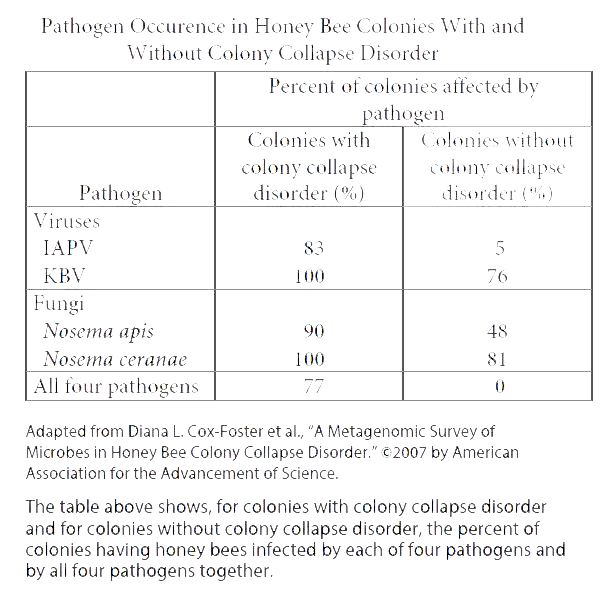Honey bees are hosts to the pathogenic large ectoparasitic mite Varroa destructor (Varroa mites). These mites feed on bee hemolymph (blood) and can kill bees directly or by increasing their susceptibility
line 5- to secondary infection with fungi, bacteria or viruses. Little is known about the natural defenses that keepthe mite infections under control. Pyrethrums are a group of flowering plants which include Chrysanthemum coccineum, Chrysanthemum
line 10- cinerariifolium, Chrysanthemum marschalli, and related species. These plants produce potent insecticides with anti-mite activity. The naturally occurring insecticides are known as pyrethrums. A synonym for the naturally occurring pyrethrums is
line 15- pyrethrin and synthetic analogues of pyrethrums are known as pyrethroids. In fact, the human mite infestation known as scabies (Sarcoptes scabiei) is treated with a topical pyrethrum cream. We suspect that the bees of commercial bee
line 20- colonies which are fed mono-crops are nutritionally deficient. In particular, we postulate that the problem is a diet deficient in anti-mite toxins: pyrethrums, and possibly other nutrients which are inherent in such plants. without, at least, intermittent feeding on
line 25- the pyrethrum producing plants, bee colonies are susceptible to mite infestations which can become fatal either directly or due to a secondary infection of immunocompromised or nutritionally deficient bees. This secondary infection can be viral, bacterial or
line 30- fungal and may be due to one or more pathogens. In addition, immunocompromised or nutritionally deficient bees may be further weakened when commercially produced insecticides are introduced into their hives by bee keepers in an effort to fight
line 35- mite infestation. We further postulate that the proper dosage necessary to prevent mite infestation may be better left to the bees, who may seek out or avoid pyrethrum containing plants depending on the amount necessary to defend against mites and the
line 40- amount already consumed by the bees, which in higher doses could be potentially toxic to them. This hypothesis can best be tested by a trial wherein a small number of commercial honey bee colonies are offered a number of pyrethrum
line 45- producing plants, as well as a typical bee food source such as clover, while controls are offered only the clover. Mites could then be introduced to each hive with note made as to the choice of the bees, and the effects of the mite parasites on the experimental
line 50 - colonies versus control colonies. It might be beneficial to test wild-type honey bee colonies in this manner as well, in case there could be some genetic difference between them that affects the bees’ preferences for pyrethrum producing flowers.

As used in line 35, “postulate” most nearly means to
make an unfounded assumption.
put forth an idea or claim.
question a belief or theory
conclude based on firm evidence.
The correct Answer is:B
Choice B is the best answer. In lines 31-35, the authors argue that beekeepers’ use of insecticides to control mite infestations may be harmful to some bees. The authors then state, “We further postulate that the proper dosage necessary to prevent mite infestation may be better left to the bees” (lines 35-37). In this context, the authors “postulate,” or put forth the idea that the bees may naturally control mite infestations better than insecticides. Choices A, C, and D are incorrect because in this context, “postulate” does not mean to make an unfounded assumption, question a belief or theory, or conclude based on firm evidence.
Similar Questions
एक सरल रेखा (2,-1,3) से गुजरती है और इसके दिक्अनुपात 3,-1,2 है | इस रेखा के समीकरण है
02:18View Solutionकौन-सा धातु नाइट्रोजन के साथ क्रिया करके सीधे नाइट्राइड बनाती है-
02:45View Solutionहम किस प्रकार कह सकते हैं कि जीवाणु हमारे मित्र हैं ? समझाड़ए।
05:21View Solutionतुई ने कार्टून चैनल के माध्यम से क्लोन के बारे में सुना तथा यह जान गयी कि "डाली" एक क्लोन भेड़ हैं । उसने अपने जीव विज्ञान के शिक्षक से चर्चा की , तब शिक्षक ने क्लोन एंव उसकी उत्पत्ति के बारे में विस्तृत रुप से बताया ।
उपर्युक्त गद्यांश के आधार पर निम्न प्रश्नों के उत्तर दीजिये - (i) क्लोन क्या हैं ?
(ii) पौधों में क्लोन का उत्पादन किस प्रकार किया जाता हैं ?
(iii) तुई ने जीव विज्ञान शिक्षक से क्लोन के बारे में जानकारी क्यों प्राप्त की ?02:43View Solutionक्या आप दस पुनर्योगज प्रोटीन के बारे में बता सकते हैं जो चिकित्सीय व्यवहार के काम में लाये जाते हैं ? पता लगाइये कि वे चिकित्सीय औषधि के रुप में कहाँ प्रयोग किए जाते हैं ?
05:28View Solutionआण्विक आकार के आधार पर एन्जाइम बड़े हैं या DNAआप इसके बारे में कैसे पता लगायेंगे ?
View Solutionक्या हमारे रुधिर में प्रोटियेजेज तथा न्युक्लीएजेज है?
01:58View Solutionकिस वैज्ञानिक के अनुसार किसी क्षेत्र की जातीय समृद्धि अन्वेषण क्षेत्र की सीमा बढ़ाने के साथ बढ़ती है?
02:26View Solution

